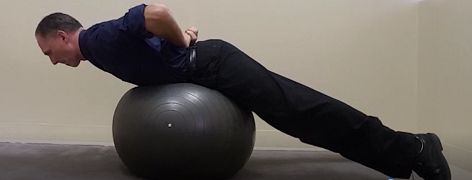The human frame is designed for motion. The human body is engineered to move effectively and efficiently. It is not designed for prolonged sitting on the couch, lengthy drives in a car and long hours at a computer work station.
Movement brings a wealth of positive effects to the spine. Motion keeps us young and helps add years to our lives. A major difference between a “young” person and an “old” person is the ability to move correctly. Motion is essential for health and fitness.
Combine proper motion with sound nutrition practices to develop the foundation of your health. Move to achieve and maintain a youthful, healthy spine.
It is my professional opinion that movement is the most vital ingredient to spine health. Proper motion increases blood flow, builds muscle strength, improves bone strength, decreases muscle tension and provides a reprise from static body positioning.
Healthy movement can be active or passive. Passive motions are performed on you by another person. Healthy passive movements include chiropractic adjustments, partner assisted stretches and assisted motion exercises.
Healthy active movement for the spine comes in multiple forms. Beneficial spinal motion includes dynamic motion exercises, static stretches, anaerobic exercises and aerobic exercise.
The spine is the nucleus of motion. The spinal column is composed of 26 articulating vertebrae that function as a unit. The lower back, or lumbar spine, is nicknamed the pillar because it supports the entire spinal column. The lower back is an essential component in the muscle group known as the core.
Intervertebral Disc: Movement supplies fluid and nutrients to the intervertebral discs (IVD.) The IVD is located between the vertebrae and serves as a shock distributor. Direct blood flow to the IVD ceases around the age of six. After that point the IVD receives its blow flow through osmosis with the vertebrae directly above and below.
Motion increases the osmotic process between the vertebrae and the IVD. Movement is the key to a healthy IVD. Small and big movements increase blood flow to the IVD.
Aerobic Exercise: Cardiovascular exercise strengthens the entire frame. Large functional movements are required during aerobic exercise. Working muscles require a larger amount of blood flow.
Cardio training recruits the muscles symmetrically side-to-side developing strength and endurance in the limbs and spine. The strong back muscles work to move and support the body during aerobic exercise. Develop stamina in your spine with cardiovascular training. Walking, swimming, cycling, dancing, roller skating and running are simple, fun endurance exercises which build spinal strength and stamina.
Anaerobic Exercise: Build strength, power and motion with resistance training. A plethora of choices exist including body weight exercises, weight machines, barbells, dumbbells, kettlebells, cables, resistance bands and Pilates. Incorporate a multitude of types of resistance training into your exercise strategies for maximum results.
Learn correct technique from a certified fitness trainer. Perform each lift with precision and pay close attention to your technique. Use perfect form each repetition.
Correct lifting technique is more important than the amount of weight. Start at an appropriate level and increase intensity gradually.
Develop strength and stability in your spine with resistance training. No matter the body’s position, the spine is involved in the exercise. Each exercise recruits the spinal muscles to move the body or stabilize the body. Strengthen your spine and the surrounding muscles with consistent resistance training.
Dynamic Motions: Moving correcting and constantly throughout the day is vital for your spine. Effective dynamic motions can be big or small. Simply rocking side to side while sitting prevents muscle tautness, stretches the spine and increases blood flow to the intervertebral discs.
Standing and walking for two minutes releases built-up muscle tension after prolonged sitting. Neck, shoulder and arm movements provide a reprise from keyboard and mouse work. Neck circles, shoulder rolls and scapular retraction movement exercises lessen neck, upper back and shoulder tightness.
Nerve Slides: Nerve slide motion exercises move the muscles and nerves to help prevent and manage nerve impingement conditions. Nerve slides are precision, non-exertion, non-resistance movements that release the nerve from scar tissue entrapment. Nerve slides assist in the prevention and management of carpal tunnel syndrome, cubital tunnel syndrome, thoracic outlet syndrome, sciatica, common peroneal nerve entrapment & tarsal tunnel syndrome.
Motion Exercises: Specific forms of exercise are designed to increase range of motion and muscle strength. Tai Chi, GYROTONIC and yoga build strength, coordination and balance while simultaneously increasing joint range of motion. Learn correct technique from a knowledgeable teacher and perform motion exercises correctly and consistently for the achievement of optimum benefits.
Static Stretching: Increase spinal mobility and flexibility with static stretching exercises. Stretch after executing dynamic motions for increased results and safety. Never stretch a cold muscle. Perform dynamic motions to increase blood flow and warm-up the muscles before stretching.
Exhale and move slowly in the stretch. Hold a slight comfortable muscle stretch. Release the stretch and slowly return to the starting position. Hold neck stretches for 10 to 20 seconds, all other areas can be stretched for 20 to 60 seconds.
Stretching should never elicit pain or symptoms. If a specific stretch causes pain or symptoms forgo that stretch and proceed to another.
Motion is essential to a healthy spine and body. Quality movement is the best medicine for spine health. Keep your musculoskeletal system strong, mobile and fit with correct movement. Incorporate motion into your spinal health strategies to increase your ability to live a healthier, fitter and more functional life.
The spine is the nucleus of movement. Perform motion exercises to keep your spine young, healthy and symptom-free.
Dr Donald A Ozello DC of Championship Chiropractic in Las Vegas, NV
Web Site: http://www.championshipchiropractic.com/
Blog: https://www.championshipchiropractic.com/wordpress/
YouTube: https://www.youtube.com/user/drdozellodc/videos
Twitter: https://twitter.com/drdozellodc
Facebook: https://www.facebook.com/Championship-Chiropractic-280141628688300/
LinkedIn: https://www.linkedin.com/in/dr-donald-a-ozello-dc-716b3233
“Running: Maximize Performance & Minimize Injuries” https://www.amazon.com/Running-Performance-Chiropractors-Minimizing-Potential/dp/1493618741
**Disclaimer: Always consult a medical professional before beginning an exercise program. Always work within your capabilities. Never perform an exercise that elicits or increases pain or symptoms. Reading this article and viewing the linked videos does not take the place of seeing a medical professional. Please visit a medical professional for evaluation, diagnosis & treatment.

